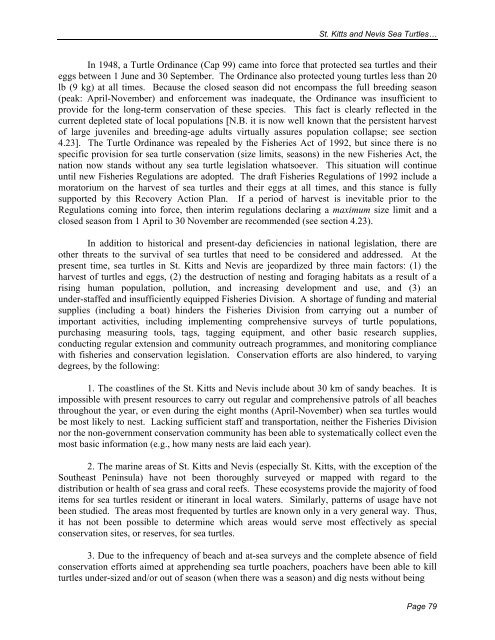Sea Turtle Recovery Action Plan for St. Kitts and Nevis - WIDECAST
Sea Turtle Recovery Action Plan for St. Kitts and Nevis - WIDECAST
Sea Turtle Recovery Action Plan for St. Kitts and Nevis - WIDECAST
Create successful ePaper yourself
Turn your PDF publications into a flip-book with our unique Google optimized e-Paper software.
<strong>St</strong>. <strong>Kitts</strong> <strong>and</strong> <strong>Nevis</strong> <strong>Sea</strong> <strong>Turtle</strong>s…<br />
In 1948, a <strong>Turtle</strong> Ordinance (Cap 99) came into <strong>for</strong>ce that protected sea turtles <strong>and</strong> their<br />
eggs between 1 June <strong>and</strong> 30 September. The Ordinance also protected young turtles less than 20<br />
lb (9 kg) at all times. Because the closed season did not encompass the full breeding season<br />
(peak: April-November) <strong>and</strong> en<strong>for</strong>cement was inadequate, the Ordinance was insufficient to<br />
provide <strong>for</strong> the long-term conservation of these species. This fact is clearly reflected in the<br />
current depleted state of local populations [N.B. it is now well known that the persistent harvest<br />
of large juveniles <strong>and</strong> breeding-age adults virtually assures population collapse; see section<br />
4.23]. The <strong>Turtle</strong> Ordinance was repealed by the Fisheries Act of 1992, but since there is no<br />
specific provision <strong>for</strong> sea turtle conservation (size limits, seasons) in the new Fisheries Act, the<br />
nation now st<strong>and</strong>s without any sea turtle legislation whatsoever. This situation will continue<br />
until new Fisheries Regulations are adopted. The draft Fisheries Regulations of 1992 include a<br />
moratorium on the harvest of sea turtles <strong>and</strong> their eggs at all times, <strong>and</strong> this stance is fully<br />
supported by this <strong>Recovery</strong> <strong>Action</strong> <strong>Plan</strong>. If a period of harvest is inevitable prior to the<br />
Regulations coming into <strong>for</strong>ce, then interim regulations declaring a maximum size limit <strong>and</strong> a<br />
closed season from 1 April to 30 November are recommended (see section 4.23).<br />
In addition to historical <strong>and</strong> present-day deficiencies in national legislation, there are<br />
other threats to the survival of sea turtles that need to be considered <strong>and</strong> addressed. At the<br />
present time, sea turtles in <strong>St</strong>. <strong>Kitts</strong> <strong>and</strong> <strong>Nevis</strong> are jeopardized by three main factors: (1) the<br />
harvest of turtles <strong>and</strong> eggs, (2) the destruction of nesting <strong>and</strong> <strong>for</strong>aging habitats as a result of a<br />
rising human population, pollution, <strong>and</strong> increasing development <strong>and</strong> use, <strong>and</strong> (3) an<br />
under-staffed <strong>and</strong> insufficiently equipped Fisheries Division. A shortage of funding <strong>and</strong> material<br />
supplies (including a boat) hinders the Fisheries Division from carrying out a number of<br />
important activities, including implementing comprehensive surveys of turtle populations,<br />
purchasing measuring tools, tags, tagging equipment, <strong>and</strong> other basic research supplies,<br />
conducting regular extension <strong>and</strong> community outreach programmes, <strong>and</strong> monitoring compliance<br />
with fisheries <strong>and</strong> conservation legislation. Conservation ef<strong>for</strong>ts are also hindered, to varying<br />
degrees, by the following:<br />
1. The coastlines of the <strong>St</strong>. <strong>Kitts</strong> <strong>and</strong> <strong>Nevis</strong> include about 30 km of s<strong>and</strong>y beaches. It is<br />
impossible with present resources to carry out regular <strong>and</strong> comprehensive patrols of all beaches<br />
throughout the year, or even during the eight months (April-November) when sea turtles would<br />
be most likely to nest. Lacking sufficient staff <strong>and</strong> transportation, neither the Fisheries Division<br />
nor the non-government conservation community has been able to systematically collect even the<br />
most basic in<strong>for</strong>mation (e.g., how many nests are laid each year).<br />
2. The marine areas of <strong>St</strong>. <strong>Kitts</strong> <strong>and</strong> <strong>Nevis</strong> (especially <strong>St</strong>. <strong>Kitts</strong>, with the exception of the<br />
Southeast Peninsula) have not been thoroughly surveyed or mapped with regard to the<br />
distribution or health of sea grass <strong>and</strong> coral reefs. These ecosystems provide the majority of food<br />
items <strong>for</strong> sea turtles resident or itinerant in local waters. Similarly, patterns of usage have not<br />
been studied. The areas most frequented by turtles are known only in a very general way. Thus,<br />
it has not been possible to determine which areas would serve most effectively as special<br />
conservation sites, or reserves, <strong>for</strong> sea turtles.<br />
3. Due to the infrequency of beach <strong>and</strong> at-sea surveys <strong>and</strong> the complete absence of field<br />
conservation ef<strong>for</strong>ts aimed at apprehending sea turtle poachers, poachers have been able to kill<br />
turtles under-sized <strong>and</strong>/or out of season (when there was a season) <strong>and</strong> dig nests without being<br />
Page 79
















